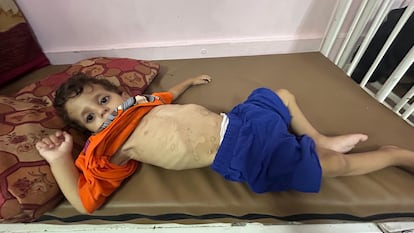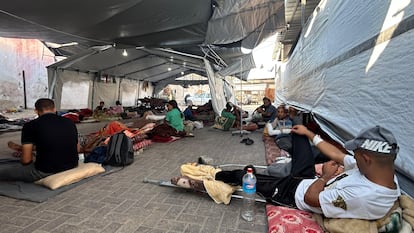"Cut off my leg, for God's sake! I can't take it anymore": The Nasser Hospital bombed by Israel is a symbol of Gaza's healthcare collapse.

The screams of Abdel Rahman Abu Shawish pierce the makeshift tent in the courtyard of Nasser Hospital in Khan Younis. The 24-year-old Palestinian, who was shot by Israeli soldiers in early August as he tried to grab a bag of flour from a humanitarian aid truck in the southern Gaza Strip, now lies in a bed he brought from home, in a tent in the hospital courtyard, because there are no free beds in the hospital.
His left foot, held in place by an external metal fixator that arrived four days late, has deteriorated to the point where it can no longer be saved. “Cut off my leg, cut off my leg! I beg you, for the love of God, cut it off. I can’t take it anymore. I’m going to die of pain,” he cries, weeping. Doctors treating Abu Shawish report that his injury caused severe damage to his veins, arteries, and nerves, with no possibility of saving his foot. The situation has been exacerbated by a shortage and overwhelming pressure on medical equipment . Access for foreign doctors is almost impossible, as is the inability for patients to receive treatment outside Gaza. Doctors deemed amputation necessary.
This scene last Sunday at Nasser Hospital, the largest in southern Gaza, occurred hours before the Israeli bombing of the medical center. Hospital officials said at least 20 people were killed, including five journalists, and several more were injured. The Gaza Ministry of Health reported that the bombing was a "double attack," as a second missile struck shortly after the first, as rescue teams arrived. The attack comes amid a conflict that, according to the Hamas-led Gaza Ministry of Health, has claimed more than 62,000 Palestinian lives since October 2023, almost half of them women and children.
Nasser Hospital represents the complete collapse of Gaza's healthcare system after 22 months of war. With medical supplies blocked at border crossings, foreign medical teams denied entry, and patients prevented from seeking treatment abroad, hospitals that once provided modern medical care now resemble 19th-century infirmaries. The hospital's director, Atef Al Hout, explains to EL PAÍS that repeated attacks on medical facilities, coupled with severe shortages of medicines, equipment, and qualified personnel, have brought Gaza's healthcare system to the brink of collapse.
The malnutrition ward [at Nasser Hospital], designed for eight children, struggles to treat 25
The orthopedic department, built for 27 patients, now houses more than 200. The malnutrition ward, designed for eight children, struggles to treat 25. Premature births are more than double the usual rate. And the medical staff, working without basic supplies like gauze and painkillers, must choose which patients deserve the few remaining beds, while the rest sleep in the hallways.
“I can’t… I can’t,” says Abu Shawish. “I’m being treated in a place not fit for human beings. I’m in an open tent, and there isn’t even a bathroom. We’re on the street.” This young man, the father of a two-month-old boy named Kanan, wonders aloud: “How is it possible that someone like me, who has just started life and started a family, could become disabled?” Without access to prosthetics, crutches, or adequate treatment, he describes living in constant pain.
Aid trucksAbu Shawish recalls that he only came to the aid trucks because he was hungry. Now, he says, he is afraid to face life in the enclave as an amputee. According to the World Health Organization (WHO) , Gaza's healthcare system is collapsing, with less than half of hospitals and just over a third of primary health care centers barely functioning. Major facilities are operating at more than double or triple their capacity, amid severe shortages of medicines, supplies, and equipment, while international medical personnel and shipments face frequent denials and delays upon entry.
I am being treated in a place that is not fit for human beings.
Abdel Rahman Abu Shawish
Hospitals are overwhelmed by the mass casualties from attacks on food distribution areas, leading to severe shortages of blood and plasma. According to the UN, from late May to mid-August, at least 1,857 Palestinians died while trying to obtain food.

The crisis is exacerbated by evacuation orders threatening warehouses and medical facilities, which in turn pose a greater risk to essential services. His father, Ashraf Abu Shawish, works as an administrator at the same hospital, but is powerless to help his son. “The occupation tortured my son twice,” he says. “First by shooting him and then by denying him treatment because they don’t allow medicines to enter or the wounded to be taken abroad for treatment.”
The collapse of Gaza's healthcare system is evident in every corner of Nasser. Dozens of orthopedic patients are crammed into two makeshift tents and the hallway between them, lying on thin mattresses they've brought from their homes. The air is thick with the groans and sudden screams of patients pleading for painkillers that the nurses can't provide because they've already run out. One man screams in frustration after being told he must wait until the next day for relief.
25 malnourished childrenAt the mother and child hospital, 25 malnourished children lie emaciated and frail, some unable to sit or speak, while their mothers weep and plead with visiting journalists for help in obtaining treatment abroad. Doctors provide nutritional supplements but warn that recovery is slow and uncertain after such prolonged deprivation. Severe malnutrition is leaving the children frail and barely able to move.
Last Sunday, the Gaza Ministry of Health reported the deaths of eight more people due to starvation , adding to the eight reported on Saturday , bringing the total number of starvation-related deaths to 289 since the start of the conflict. On Friday, the UN officially confirmed that residents of Gaza City and the surrounding area were suffering from famine. In total, some 514,000 people—almost a quarter of Gaza's population—are facing famine, and that number is expected to rise to 641,000 by the end of September.
Two-year-old Abdel Rahman Kallab was admitted ten days ago after his weight plummeted over the course of a month, weakened by persistent diarrhea and a lack of proper food. His mother, Ilham Kallab, cradles him in his hospital bed, sometimes leaving him on the mattress as she battles the fear of losing him. “We didn’t have any suitable food for a newly weaned child: no fruits, no vegetables, no meat,” she adds. “The only thing available were lentils and legumes, which caused diarrhea and worsened his condition.”

His mother explains that the little boy "has been recovering very slowly for ten days. I was hoping to give him protein, healthy fats, or fruit, but there's nothing available on the market, at high prices or otherwise." She's also worried about her five other children, who have been left behind in a tent for displaced persons in similar conditions, fearing their health will deteriorate.
Ahmed Al Farra, director of the Nasser Maternal and Child Hospital, confirms that the hospital is under unprecedented pressure. His department received 100 cases per day before the war, but now the figure exceeds 700. Furthermore, overnight stays at the hospital used to be no more than six per day, but now reach 60. “The malnutrition department, for example, is designed to accommodate eight patients, but now there are 25 children hospitalized, and we also have two malnutrition clinics that should receive 50 cases, but instead treat 240 weekly,” he explains to EL PAÍS.
Select the most critical patientsThe director of the mother and child hospital adds that the staff is living a nightmare, as doctors are forced to choose which patients can stay overnight and prioritize the most critical cases. According to Al Farra, overall health conditions are deteriorating rapidly. Before the war, the ideal birth weight was 3 to 3.5 kilograms, while now it ranges between 1.5 and 2.5 kilograms.
“Calling it a disaster is a polite way of putting it. In reality, the system is in critical condition,” Al Hout, the director of Nasser, told EL PAÍS. He explains that they don’t even have basic supplies like saline solution. Antibiotics are scarce, wound dressings are out of stock, and medicines are out of stock. “We are facing a desperate situation, largely because the occupation is preventing the entry of even the most basic medical supplies.”
Al Hout confirms that deaths have occurred due to the shortcomings of the healthcare system. Before the war, Nasser Hospital had a maximum capacity of 342 beds, including 12 intensive care units and eight cardiac care units. Most other hospitals in the south have been destroyed or have ceased to function, and to cope with the situation, the hospital expanded its capacity: adding beds to existing rooms, utilizing corridors, and eventually establishing field hospitals. Capacity increased from 342 to 500, then to 588 with external tents, and now exceeds 1,000, three times the original capacity.
The hospital is unable to perform even basic blood tests, except in intensive care or emergency cases, due to a lack of laboratory equipment. Its three X-ray machines, scheduled to be replaced by the end of 2023 thanks to a Japanese donation, are now handling around 1,000 cases daily, three times its normal load. The CT scanner, designed for 60 cases a day, is processing 300. “These numbers are only a small part of the crisis,” says Al Hout. “The collapse of the healthcare system is deeper and more dangerous than these numbers can convey.”
Nurse Mohammed Aslan, who has worked in every war since 2008, says conditions are less than 10% of pre-conflict standards. “The capacity of the two tents I oversee shouldn't exceed 45 patients, but at times it's reached 110, and now there are more than 80, all of them on the floor,” he says. Often, just two nurses oversee more than 40 patients, rationing dressings and delaying wound care. “We provide what we have, not what they need,” he says.
EL PAÍS





